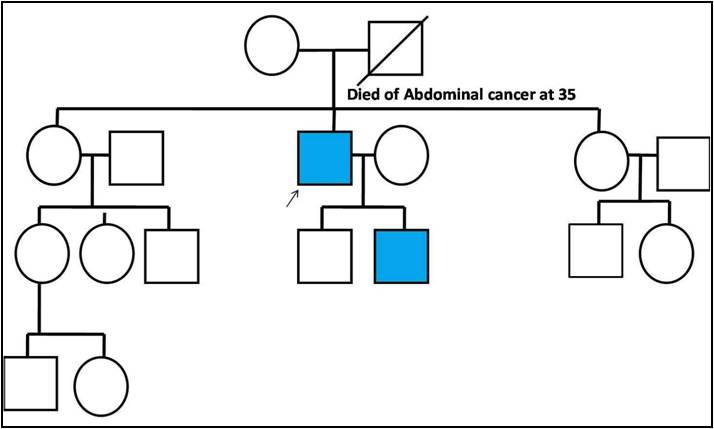A Unique case of Multiple Endocrine Neoplasm-1 Syndrome satisfying all six WHO criteria
Keywords:
Multiple Endocrine Neoplasia type 1, parathyroid hyperplasia, thymic carcinoid, pituitary adenoma
Abstract
Multiple Endocrine Neoplasia (MEN) syndromes are a group of genetically inherited diseases resulting in proliferative lesions (hyperplasia, adenomas and carcinomas) of the endocrine organs. MEN 1 syndrome principally includes tumors of parathyroid, pancreas and pituitary. Our case is a 45 year old male, previously operated for thymic carcinoma, subsequently presented with radiologically and pathologically confirmed neuroendocrine lesions involving pituitary, parathyroid, adrenal, pancreas, stomach and duodenum. This patient had a positive family history for MEN 1 syndrome thus satisfying all six WHO criteria for MEN 1 syndrome which is a rare observation with no previous published reports. Tumors in this syndrome are more aggressive and recur in higher proportion of cases than do similar tumors occurring sporadically in non-syndromic patients.References
1) Marini F, Falchetti A, Del Monte F, Carbonell Sala S, Gozzini A, Luzi E et al. Multiple endocrine neoplasia type 1. Orphanet J Rare Dis 2006;1:38.
2) Calender A, Scoazec JY, Morrison CD, Sweet KM, Komminoth P, Teh BT. Inherited tumor syndromes-Multiple endocrine neoplasia type one. In: DeLellis RA, Lloyd RV, Heitz PU, Eng C, editors. World Health Organisation Classification of Tumors. Pathology and Genetics of Tumors of Endocrine Organs. 3rd ed. Lyon, France: IARC Press; 2004. pp. 218-27.
3) Teh BT, Grimmond S, Shepherd J, Larsson C, Hayward N. Multiple endocrine neoplasia type 1: clinical syndrome to molecular genetics. Aust NZ J Surg 1995;65:708-13.
4) Hoff AO, Hauache OM. Multiple endocrine neoplasia type 1 (MEN 1): clinical, biochemical and molecular diagnosis and treatment of the associated disturbances. Arq Bras Endocrinol Metabol 2005;49:735-46.
5) Teh BT, Zedenius J, Kytölä S, Skogseid B, Trotter J, Choplin H et al. Thymic carcinoids in multiple endocrine neoplasia type 1. Ann Surg 1998;228:99-105.
6) Chandrasekharappa SC, Guru SC, Manickam P, Olufemi SE, Collins FS, Emmert-Buck MR et al. Positional cloning of the gene for multiple endocrine neoplasia-type 1. Science 1997;276:404-7
7) Thakker RV. Multiple endocrine neoplasia type 1. Indian J Endocrinol Metab 2012;16 Suppl 2:272-74.
8) Gaztambide S, Vazquez F, Castaño L. Diagnosis and treatment of multiple endocrine neoplasia type 1 (MEN1). Minerva Endocrinol 2013;38:17-28.
9) Shah SR, Raghavan R, Desai DC, Chauhan PH, Lala M, Dherai AJ, Ashavaid TF. An Indian family of multiple endocrine neoplasia type 1(MEN1): molecular diagnosis, treatment and follow up. Indian J Gastroenterol. 2008;27:242-44.
2) Calender A, Scoazec JY, Morrison CD, Sweet KM, Komminoth P, Teh BT. Inherited tumor syndromes-Multiple endocrine neoplasia type one. In: DeLellis RA, Lloyd RV, Heitz PU, Eng C, editors. World Health Organisation Classification of Tumors. Pathology and Genetics of Tumors of Endocrine Organs. 3rd ed. Lyon, France: IARC Press; 2004. pp. 218-27.
3) Teh BT, Grimmond S, Shepherd J, Larsson C, Hayward N. Multiple endocrine neoplasia type 1: clinical syndrome to molecular genetics. Aust NZ J Surg 1995;65:708-13.
4) Hoff AO, Hauache OM. Multiple endocrine neoplasia type 1 (MEN 1): clinical, biochemical and molecular diagnosis and treatment of the associated disturbances. Arq Bras Endocrinol Metabol 2005;49:735-46.
5) Teh BT, Zedenius J, Kytölä S, Skogseid B, Trotter J, Choplin H et al. Thymic carcinoids in multiple endocrine neoplasia type 1. Ann Surg 1998;228:99-105.
6) Chandrasekharappa SC, Guru SC, Manickam P, Olufemi SE, Collins FS, Emmert-Buck MR et al. Positional cloning of the gene for multiple endocrine neoplasia-type 1. Science 1997;276:404-7
7) Thakker RV. Multiple endocrine neoplasia type 1. Indian J Endocrinol Metab 2012;16 Suppl 2:272-74.
8) Gaztambide S, Vazquez F, Castaño L. Diagnosis and treatment of multiple endocrine neoplasia type 1 (MEN1). Minerva Endocrinol 2013;38:17-28.
9) Shah SR, Raghavan R, Desai DC, Chauhan PH, Lala M, Dherai AJ, Ashavaid TF. An Indian family of multiple endocrine neoplasia type 1(MEN1): molecular diagnosis, treatment and follow up. Indian J Gastroenterol. 2008;27:242-44.

Published
2016-10-03
Issue
Section
Case Report
Authors who publish with this journal agree to the following terms:
- Authors retain copyright and grant the journal right of first publication with the work simultaneously licensed under a Creative Commons Attribution License that allows others to share the work with an acknowledgement of the work's authorship and initial publication in this journal.
- Authors are able to enter into separate, additional contractual arrangements for the non-exclusive distribution of the journal's published version of the work (e.g., post it to an institutional repository or publish it in a book), with an acknowledgement of its initial publication in this journal.
- Authors are permitted and encouraged to post their work online (e.g., in institutional repositories or on their website) prior to and during the submission process, as it can lead to productive exchanges, as well as earlier and greater citation of published work (See The Effect of Open Access at http://opcit.eprints.org/oacitation-biblio.html).




